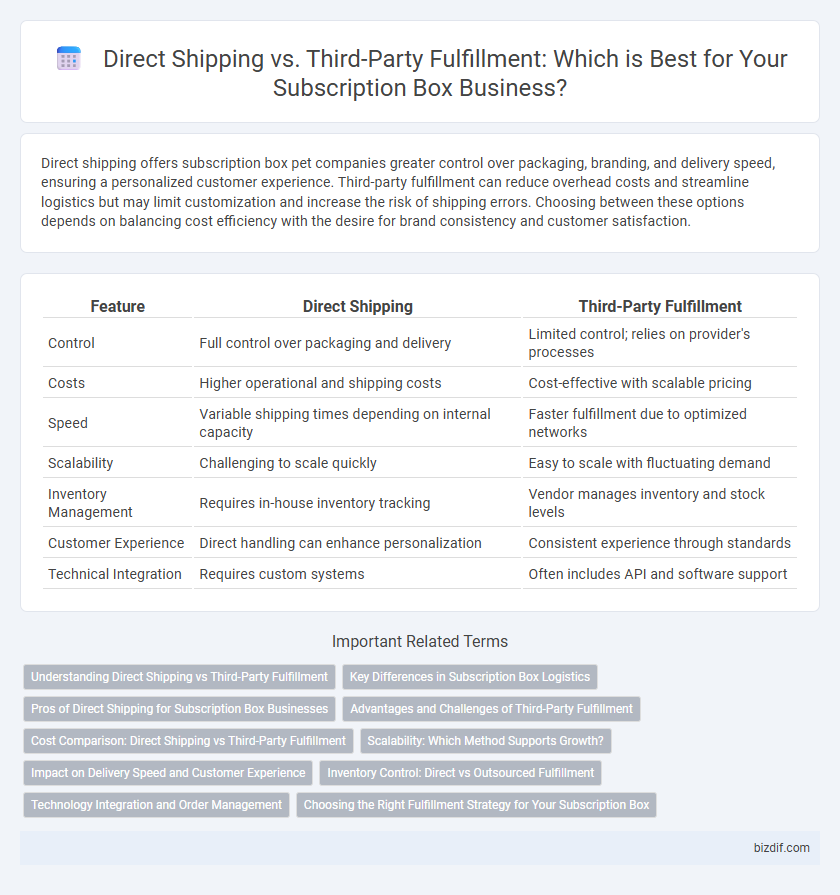Direct shipping offers subscription box pet companies greater control over packaging, branding, and delivery speed, ensuring a personalized customer experience. Third-party fulfillment can reduce overhead costs and streamline logistics but may limit customization and increase the risk of shipping errors. Choosing between these options depends on balancing cost efficiency with the desire for brand consistency and customer satisfaction.
Table of Comparison
| Feature | Direct Shipping | Third-Party Fulfillment |
|---|---|---|
| Control | Full control over packaging and delivery | Limited control; relies on provider's processes |
| Costs | Higher operational and shipping costs | Cost-effective with scalable pricing |
| Speed | Variable shipping times depending on internal capacity | Faster fulfillment due to optimized networks |
| Scalability | Challenging to scale quickly | Easy to scale with fluctuating demand |
| Inventory Management | Requires in-house inventory tracking | Vendor manages inventory and stock levels |
| Customer Experience | Direct handling can enhance personalization | Consistent experience through standards |
| Technical Integration | Requires custom systems | Often includes API and software support |
Understanding Direct Shipping vs Third-Party Fulfillment
Direct shipping involves sending products straight from the manufacturer or supplier to the customer, reducing handling time and potentially lowering shipping costs. Third-party fulfillment uses specialized fulfillment centers to store, pack, and ship products on behalf of the business, offering scalability and streamlined inventory management. Choosing between direct shipping and third-party fulfillment depends on factors like order volume, control over packaging, and speed of delivery.
Key Differences in Subscription Box Logistics
Direct shipping in subscription box logistics involves sending products straight from the supplier to the customer, minimizing handling time and reducing shipping costs. Third-party fulfillment, on the other hand, relies on external warehouses to store, pack, and ship boxes, allowing scalable operations but potentially increasing delivery times and complexity. The key differences lie in control over inventory, shipping speed, and overall cost-efficiency.
Pros of Direct Shipping for Subscription Box Businesses
Direct shipping offers subscription box businesses greater control over order accuracy and packaging quality, ensuring a consistent brand experience. By managing inventory and shipping in-house, companies can reduce lead times, enabling faster delivery to customers and greater flexibility in handling special requests. This approach also helps maintain direct communication with customers, fostering stronger relationships and enhancing overall satisfaction.
Advantages and Challenges of Third-Party Fulfillment
Third-party fulfillment offers subscription box businesses scalable logistics, access to advanced warehousing technology, and reduced overhead costs by outsourcing inventory management and shipping processes. Challenges include less direct control over packaging quality and delivery speed, potential communication delays, and reliance on third-party accuracy for order fulfillment. Choosing third-party services can enhance operational efficiency but requires careful vendor selection to maintain customer satisfaction and brand consistency.
Cost Comparison: Direct Shipping vs Third-Party Fulfillment
Direct shipping typically incurs lower costs per order due to reduced handling and storage fees but may require higher upfront investment in logistics infrastructure. Third-party fulfillment services offer scalable solutions with variable pricing models, often including storage, packaging, and shipping fees that can increase overall expenses. Businesses must evaluate order volume and operational complexity to determine which option provides the most cost-effective fulfillment strategy.
Scalability: Which Method Supports Growth?
Direct shipping offers complete control over inventory and customer experience but may struggle with scalability due to limited handling capacity. Third-party fulfillment centers leverage extensive infrastructure and automation, enabling faster order processing and seamless expansion to meet increasing demand. Scalability is significantly enhanced through third-party fulfillment services, making them a preferred choice for subscription box businesses aiming for rapid growth.
Impact on Delivery Speed and Customer Experience
Direct shipping in subscription box services often results in faster delivery times due to the control sellers have over inventory and shipping processes, enhancing customer satisfaction through timely arrivals. Third-party fulfillment centers may induce variable delivery speeds as orders are processed through external warehouses, potentially leading to delays and decreased predictability. Customer experience improves significantly when delivery speed aligns with expectations, making fulfillment method a critical factor in subscription box operations.
Inventory Control: Direct vs Outsourced Fulfillment
Direct shipping offers greater inventory control by allowing companies to manage stock, monitor real-time availability, and quickly address discrepancies, reducing the risk of stockouts or overstocking. In contrast, third-party fulfillment services outsource inventory management, relying on external warehouses, which can introduce delays in stock updates and less granular control over inventory levels. Companies must weigh the benefits of hands-on inventory oversight in direct shipping against the scalability and operational convenience offered by third-party fulfillment.
Technology Integration and Order Management
Direct shipping allows seamless technology integration with in-house order management systems, enabling real-time inventory updates and customized customer experiences. Third-party fulfillment leverages advanced logistics software to automate order processing but may face challenges syncing data across different platforms. Efficient order management depends on the compatibility of technology stacks, affecting shipment speed and accuracy in subscription box services.
Choosing the Right Fulfillment Strategy for Your Subscription Box
Direct shipping offers complete control over packaging and customer experience, enhancing brand consistency for subscription boxes. Third-party fulfillment provides scalability and reduced operational burdens, ideal for rapidly growing subscription services. Evaluating order volume, budget, and customer expectations helps determine the optimal fulfillment strategy tailored to your subscription box business.
Direct shipping vs Third-party fulfillment Infographic

 bizdif.com
bizdif.com